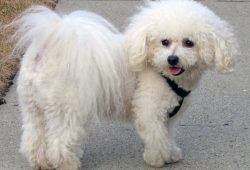A Bichon Frise is a small breed of dog of the Bichon type. The Bichon Frise is a member of the [wiki title=”Non-Sporting_Group” base=”EN”]Non-Sporting Group[/wiki] of dog breeds in the [wiki title=”United_States” base=”EN”]United States[/wiki], and a member of the [wiki title=”Toy_Group” base=”EN”]Toy Dog Group[/wiki] in the [wiki title=”United_Kingdom” base=”EN”]United Kingdom[/wiki].
Description
Appearance
The Bichon Frise is a small dog that weighs approximately 5–10 kg (10–20 lbs) and stands 23–30 cm (9–12 in) at the withers, but slightly larger dogs are not uncommon. The skull is slightly rounded and the muzzle is not pointy. The tail is groomed to be long and curly and is carried over the back. It has a black nose and dark round eyes; its white hair consists of a curly, dense coat with little shedding (much like a poodle in this respect), although many of the breed do tend to have less curly hair than others. A small amount of buff, cream, or apricot color may be seen around its ears, snout, paws or body, but normally these colors do not exceed 10% of its body.
Temperament
The American Kennel Club (AKC) refers to the Bichon Frise as “merry” and “cheerful”, and the breed standard calls for a dog that is “gentle mannered, sensitive, playful and affectionate”. The Bichon Frise loves human company and demands much of your attention. They are generally very sociable and do well with an owner that takes them along on outings. They are charming, affectionate, and intelligent. Bichons do well with children because they are playful and have lots of energy. If affiliated with a particular territory and encouraged by owners, they can become very territorial. Bred to be companion dogs, the Bichon Frise tends to get along well with both children and other animals.
Health
Bichon Frises are prone to scratching and chewing on themselves which commonly results in serious skin conditions. They are hypoallergenic but they themselves suffer from allergies to fleas, chemicals, pollen, dust, etc. Loose knee joints, ear infections, cataracts, diabetes, and heart disease are also common ailments that the breed is known to suffer from.
Hypoallergenic qualities and shedding
Bichon Frises often appear on lists of dogs that do not shed (moult). The grooming required to maintain the Bichon Frise’s coat helps remove loose hair, and the curl in the coat helps prevent dead hair and dander from escaping into the environment, as with the poodle’s coat. The frequent trimming, brushing, and bathing required to keep the Bichon looking its best removes hair and dander and controls the other potent allergen, saliva.
It is best to have a Bichon Frise groomed approximately every four to eight weeks. Daily brushing of the coat helps to prevent matting. If a Bichon’s coat gets severely matted, they may develop a [wiki title=”Hematoma” base=”EN”]hematoma[/wiki], most likely in the ears.
Bichon Frise. (2017, July 17). In Wikipedia, The Free Encyclopedia. Retrieved from https://en.wikipedia.org/w/index.php?title=Bichon_Frise&oldid=790974644


